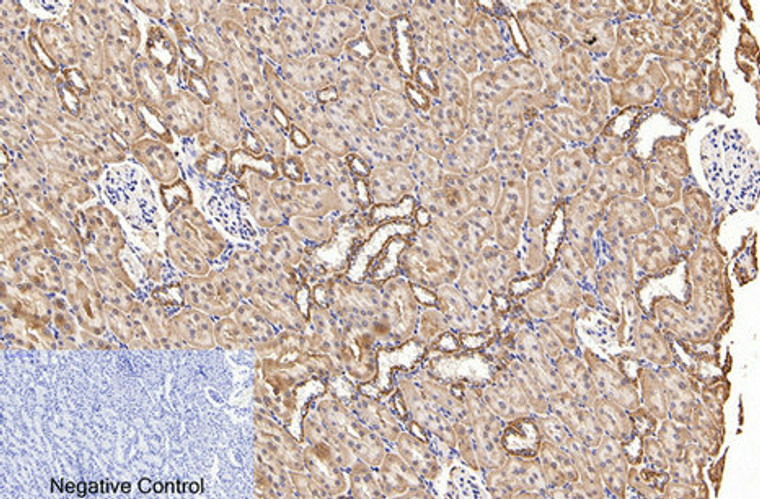-
Western blot analysis of Hela, diluted at 1) 1:2000 2) 1:5000
-
Immunofluorescence analysis of Mouse-kidney tissue. 1, COX IV monoclonal antibody (6C8) (red) was diluted at 1:200 (4°C, overnight). 2, Cy3 labled Secondary antibody was diluted at 1:300 (room temperature, 50min).3, Picture B: DAPI (blue) 10min. Picture A:Target. Picture B: DAPI. Picture C: merge of A+B
-
Immunofluorescence analysis of Rat-kidney tissue. 1, COX IV monoclonal antibody (6C8) (red) was diluted at 1:200 (4°C, overnight). 2, Cy3 labled Secondary antibody was diluted at 1:300 (room temperature, 50min).3, Picture B: DAPI (blue) 10min. Picture A:Target. Picture B: DAPI. Picture C: merge of A+B
-
Immunohistochemical analysis of paraffin-embedded Mouse-colon tissue. 1, COX IV monoclonal antibody (6C8) was diluted at 1:200 (4°C, overnight). 2, Sodium citrate pH 6.0 was used for antibody retrieval (>98°C, 20min). 3, Secondary antibody was diluted at 1:200 (room tempeRature, 30min). Negative control was used by secondary antibody only.
-
Immunohistochemical analysis of paraffin-embedded Rat-kidney tissue. 1, COX IV monoclonal antibody (6C8) was diluted at 1:200 (4°C, overnight). 2, Sodium citrate pH 6.0 was used for antibody retrieval (>98°C, 20min). 3, Secondary antibody was diluted at 1:200 (room tempeRature, 30min). Negative control was used by secondary antibody only.
-
Immunohistochemical analysis of paraffin-embedded Human-uterus-cancer tissue. 1, COX IV monoclonal antibody (6C8) was diluted at 1:200 (4°C, overnight). 2, Sodium citrate pH 6.0 was used for antibody retrieval (>98°C, 20min). 3, Secondary antibody was diluted at 1:200 (room tempeRature, 30min). Negative control was used by secondary antibody only.
-
Western blot analysis of lysates from 1) COS7, 2) 3T3, 3) Hela cells, (Green) primary antibody was diluted at 1:1000, 4°C over night, Dylight 800 secondary antibody (NA) was diluted at 1:10000, 37°C 1hour. (Red) Actin Beta Polyclonal Antibody (STJ91464) antibody was diluted at 1:5000 as loading control, 4°C over night, Dylight 680 secondary antibody (NA) was diluted at 1:10000, 37°C 1hour.
-
Immunofluorescence analysis of Hela cell. 1, AF-10 Polyclonal Antibody (red) was diluted at 1:200 (4°C overnight). COX IV monoclonal antibody (6C8) (green) was diluted at 1:200 (4°C overnight). 2, Goat Anti Rabbit Alexa Fluor 594 Catalog: (NA was diluted at 1:1000 (room temperature, 50min). Goat Anti Mouse Alexa Fluor 488 Catalog: (NA was diluted at 1:1000 (room temperature, 50min).













